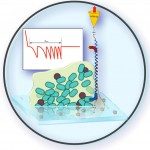Link to Pubmed [PMID] – 25559389
Nanoscale. 2015 Feb 14;7(6):2325-35
Recent advances in nanotechnology have seen the development of a number of microbiocidal and/or anti-adhesive nanoparticles displaying activity against biofilms. In this work, trimeric thiomannoside clusters conjugated to nanodiamond particles (ND) were targeted for investigation. NDs have attracted attention as a biocompatible nanomaterial and we were curious to see whether the high mannose glycotope density obtained upon grouping monosaccharide units in triads might lead to the corresponding ND-conjugates behaving as effective inhibitors of E. coli type 1 fimbriae-mediated adhesion as well as of biofilm formation. The required trimeric thiosugar clusters were obtained through a convenient thiol-ene “click” strategy and were subsequently conjugated to alkynyl-functionalized NDs using a Cu(I)-catalysed “click” reaction. We demonstrated that the tri-thiomannoside cluster-conjugated NDs (ND-Man3) show potent inhibition of type 1 fimbriae-mediated E. coli adhesion to yeast and T24 bladder cells as well as of biofilm formation. The biofilm disrupting effects demonstrated here have only rarely been reported in the past for analogues featuring such simple glycosidic motifs. Moreover, the finding that the tri-thiomannoside cluster (Man3N3) is itself a relatively efficient inhibitor, even when not conjugated to any ND edifice, suggests that alternative mono- or multivalent sugar-derived analogues might also be usefully explored for E. coli-mediated biofilm disrupting properties.





